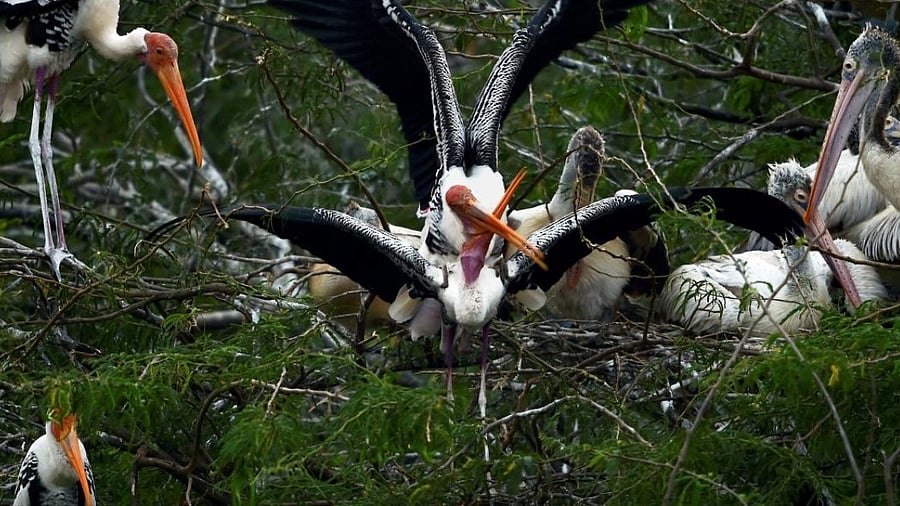
One of the last remaining natural habitats in Chennai, Pallikaranai is home to 164 species of plants, 190 birds, 10 mammals, 21 reptiles, 10 amphibians, 50 fishes, 14 butterflies, 73 phytoplanktons, and 20 dragonflies, among others.
Credit: PTI Photo
Chennai: Encroachments by government institutions and private individuals on the Pallikaranai Marshland, a treasure trove of biodiversity and one of the last remaining wetlands in the city, is cited as one of the prime reasons for excessive flooding in South Chennai.
As the city comes under water every monsoon with the southern part of Chennai bearing the brunt, the Tamil Nadu government has mooted an ambitious plan to restore about 700 hectares of the marshland as part of its flood mitigation measures.
The marshland which will now be restored was recovered from various government departments over the years, even as much of the 7,000 hectares in the ecologically sensitive zone continue to be encroached upon.
One of the last remaining natural habitats in Chennai, Pallikaranai is home to 164 species of plants, 190 birds, 10 mammals, 21 reptiles, 10 amphibians, 50 fishes, 14 butterflies, 73 phytoplanktons, and 20 dragonflies, among others.
Over the years, government buildings, a dump yard, and numerous high-rise apartment complexes have sprung up in the marshland, which activists say obstruct the flow of rain water from several parts of the city draining into the ocean.
Areas in and around Pallikaranai and other localities in South Chennai get marooned during every monsoon forcing authorities to mount massive rescue efforts, including using boats to get people to safe places.
The restoration project, which will be implemented as part of the Tamil Nadu - Sustainably Harnessing Ocean Resources and Blue Economy (TN - SHORE) with funding from the World Bank, will clear the Perumbakkam Channel of debris, solid waste and other impediments to allow flood water to enter the marshland.
Officials said the project will also include earthwork excavation, bund formation, consolidation of bund by raising plantations on either side of the walk path with indigenous tree species, and construction of small bridges across waterways in the marshland.
An integral part of the vast Bay of Bengal Marine Ecosystem and playing a vital role in balancing the water regime of the city, the marshland will ensure water security during drier months of the year and offer scope for flood mitigation during the monsoon.
Planting of taller size indigenous tree species will not just fortify the bund but also contribute to the overall enhancement and sustenance of the surrounding ecosystem, the official said, adding debris along the marshland will be removed and vegetation will also be cleared to ensure unobstructed flow in the waterways.
Eichhornia crassipes, commonly known as common water hyacinth, will be also removed from the area to conserve water in the wetlands.
Prabhakaran Veeraarasu, environmental engineer with NGO Poovulagin Nanbargal, said marshlands play a critical role in ground water recharge but the Pallikaranai marshland has long been used as a dump yard with sewage flowing on both sides. Identifying encroachment as the “root problem”, Veeraarasu said the state government should first mark the boundaries of the marshland to protect the zone from further violations.
“We should go for nature-based solutions rather than pushing technocratic ones. The government should go for multiple decentralised micro sewage plants near the Marsh to ensure that the sewage flowing from all sides doesn’t enter the marshland instead of treating it at a centralised plant,” Veeraarasu said.
Marshlands are usually known as carbon sinks and offset the effects of climate change, but a dump yard and overflowing of sewage has made the zone more susceptible to the effects of climate change. “Heavy metals are found in water in the area and every parameter exceeds. We should find a long-term solution to the problem,” the scientist added.
An area of 1247.54 hectares has been designated as Ramsar site in April 2022 and the marshland over the years has degraded due to the conversion of a partial area of the marsh as a solid waste landfill and reclamation of the marsh for the establishment of institutions and commercial organisations.